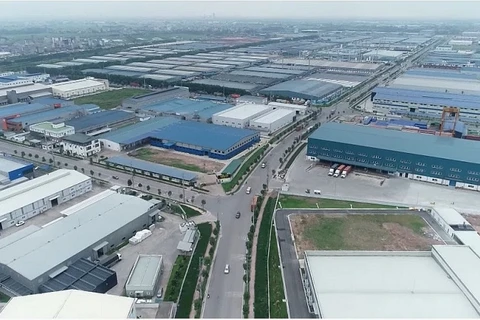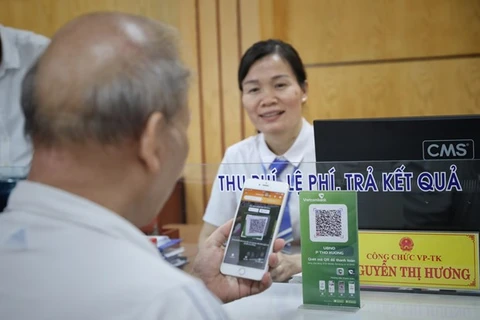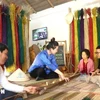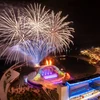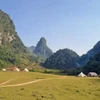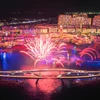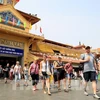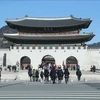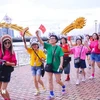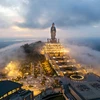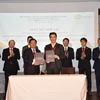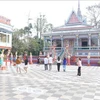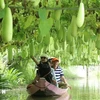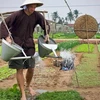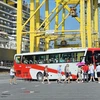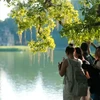Hanoi (VNA) – The northern province of Bac Giang is set to take a series of measures to create a breakthrough in tourism development and turning it into a key economic sector, a provincial official has said.
Tran Minh Ha, Director of the provincial Department of Culture, Sports and Tourism, said the plan is to build Bac Giang into an important tourist destination on the Hanoi - Lang Son tourist route. To that end, the province aims to build its local tourism brand of an attractive cultural - spiritual and ecological destination.
Accordingly, Bac Giang prioritises developing its typical tourism products such as a tour following the footsteps of King-Monk Tran Nhan Tong (1258-1308), river sightseeing tours, eco- and golf tourism activities, resorts, festivals, and tours to craft villages.
In the future, the province will pour capital into expanding five tourism spaces, including Tay Yen Tu in Son Dong, Luc Nam, Luc Ngan and Yen Dung districts; agro-ecological tourism space; tourism space associated with Yen The Uprising; space for tourism, sports and entertainment services; and Quan ho (love duet) cultural space.
Bac Giang will work on the formation of at least one national tourism site in the province. It will also strive to complete the construction of the Tay Yen Tu spiritual and ecological tourism complex, and invite investors to build sport, resort and spiritual entertainment complexes as well as hi-end hotels in Bac Giang city.
Ha went on to say that from now until the end of 2022, the province will actively respond to the "Vietnamese people travel in Vietnam", "Bac Giang people travel in Bac Giang", "Scent of Summer Luc Ngan" programmes and Sweet Fruit Week 2022.
Sides involved in the local tourism sector, such as businesses and accommodation and services providers, have been recommended to improve the quality of their products and services.
The number of visitors to the province was estimated at 900,000 in the first six months of this year, up 80% compared to the same period last year. Of which, international tourists reached 11,000, up 55% year-on-year and domestic visitors hit 889,000, an increase 75% year-on-year. The room occupancy rate was estimated at 75%.
The province is striving to turn tourism into one of its pillar economic sector.
During the 2016-2020 period, tourism became an important economic sector with a high proportion in the local economic structure. The total number of tourist arrivals was estimated at nearly 7.7 million, including around 83,000 foreigners and some 7.6 million domestic visitors, earning over 4 trillion VND (171 million USD).
In 2016, the provincial People’s Committee approved a policy of investing in six tourism projects worth over 2.54 trillion VND. These included Tay Yen Tu spiritual - ecological tourism project worth more than 1.48 trillion VND; Bac Ha hotel valued at around 40 billion VND in Bac Giang city; Bac Ha – Yen Tu rest stop worth nearly 36 billion VND in Tuan Mau commune, Son Dong district and Sun Resort worth 40 billion VND in Yen Lu commune, Yen Dung district.
The province also added new sites, including Khe Hang Dau ecological area worth over 497 billion VND in Nham Son commune, Yen Dung district, and a smart hotel and shopping mall complex worth 450 billion VND on Nguyen Van Cu street, Bac Giang city.
Bac Giang province possesses huge potential to build various kinds of tourism products. For example, the Lang Son-Hanoi-Hai Phong-Quang Ninh economic corridor has stunning natural landscapes like Tay Yen Tu Natural Reserve, Khe Ro primitive forest, Dong Cao plateau, and Khuon Than lake.
It is preserving a number of special cultural heritages, four of which were recognised by UNESCO as intangible cultural heritages. These include the stunning and emotional Quan Ho folk songs which are unique to Bac Giang and worthy of branding as a tourism draw in their own right. More musical features of the region include the Ca Tru (ceremonial singing), Then singing and Vinh Nghiem pagoda’s woodblock.
The province is also home to nearly 2,300 historical and cultural relics and a large number of beautiful landscapes. These features are in play to develop numerous tourism models such as eco-tourism, resorts, spiritual tourism and craft village tourism./.
Tran Minh Ha, Director of the provincial Department of Culture, Sports and Tourism, said the plan is to build Bac Giang into an important tourist destination on the Hanoi - Lang Son tourist route. To that end, the province aims to build its local tourism brand of an attractive cultural - spiritual and ecological destination.
Accordingly, Bac Giang prioritises developing its typical tourism products such as a tour following the footsteps of King-Monk Tran Nhan Tong (1258-1308), river sightseeing tours, eco- and golf tourism activities, resorts, festivals, and tours to craft villages.
In the future, the province will pour capital into expanding five tourism spaces, including Tay Yen Tu in Son Dong, Luc Nam, Luc Ngan and Yen Dung districts; agro-ecological tourism space; tourism space associated with Yen The Uprising; space for tourism, sports and entertainment services; and Quan ho (love duet) cultural space.
Bac Giang will work on the formation of at least one national tourism site in the province. It will also strive to complete the construction of the Tay Yen Tu spiritual and ecological tourism complex, and invite investors to build sport, resort and spiritual entertainment complexes as well as hi-end hotels in Bac Giang city.
Ha went on to say that from now until the end of 2022, the province will actively respond to the "Vietnamese people travel in Vietnam", "Bac Giang people travel in Bac Giang", "Scent of Summer Luc Ngan" programmes and Sweet Fruit Week 2022.
Sides involved in the local tourism sector, such as businesses and accommodation and services providers, have been recommended to improve the quality of their products and services.
The number of visitors to the province was estimated at 900,000 in the first six months of this year, up 80% compared to the same period last year. Of which, international tourists reached 11,000, up 55% year-on-year and domestic visitors hit 889,000, an increase 75% year-on-year. The room occupancy rate was estimated at 75%.
The province is striving to turn tourism into one of its pillar economic sector.
During the 2016-2020 period, tourism became an important economic sector with a high proportion in the local economic structure. The total number of tourist arrivals was estimated at nearly 7.7 million, including around 83,000 foreigners and some 7.6 million domestic visitors, earning over 4 trillion VND (171 million USD).
In 2016, the provincial People’s Committee approved a policy of investing in six tourism projects worth over 2.54 trillion VND. These included Tay Yen Tu spiritual - ecological tourism project worth more than 1.48 trillion VND; Bac Ha hotel valued at around 40 billion VND in Bac Giang city; Bac Ha – Yen Tu rest stop worth nearly 36 billion VND in Tuan Mau commune, Son Dong district and Sun Resort worth 40 billion VND in Yen Lu commune, Yen Dung district.
The province also added new sites, including Khe Hang Dau ecological area worth over 497 billion VND in Nham Son commune, Yen Dung district, and a smart hotel and shopping mall complex worth 450 billion VND on Nguyen Van Cu street, Bac Giang city.
Bac Giang province possesses huge potential to build various kinds of tourism products. For example, the Lang Son-Hanoi-Hai Phong-Quang Ninh economic corridor has stunning natural landscapes like Tay Yen Tu Natural Reserve, Khe Ro primitive forest, Dong Cao plateau, and Khuon Than lake.
It is preserving a number of special cultural heritages, four of which were recognised by UNESCO as intangible cultural heritages. These include the stunning and emotional Quan Ho folk songs which are unique to Bac Giang and worthy of branding as a tourism draw in their own right. More musical features of the region include the Ca Tru (ceremonial singing), Then singing and Vinh Nghiem pagoda’s woodblock.
The province is also home to nearly 2,300 historical and cultural relics and a large number of beautiful landscapes. These features are in play to develop numerous tourism models such as eco-tourism, resorts, spiritual tourism and craft village tourism./.
VNA


